Natural preservatives can keep your DIY perfume fresh and stable for longer. You'll want to use citric acid as your primary preservative, while grapefruit seed extract (GSE) offers excellent protection against bacteria and fungi at 0.1-1.0%. For oil-based perfumes, vitamin E acts as an antioxidant, while glycerin helps prevent moisture issues. Combining multiple preservatives, like GSE with rosemary extract, creates a more effective preservation system. Discover how these natural options can transform your perfume-making journey.
Understanding Natural Preservatives in DIY Perfumes
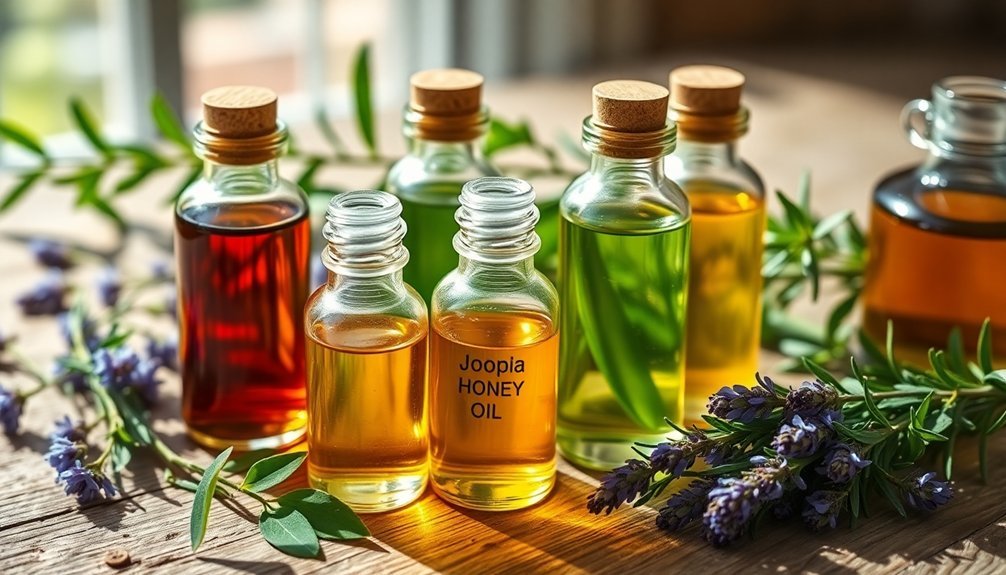
When creating your own DIY perfume, understanding natural preservatives isn't just about extending shelf life—it's essential for safety and stability.
You'll want to evaluate citric acid as your primary preservative, as it's derived from citrus fruits and helps prevent ingredient separation while offering cosmetic benefits.
You can also explore sodium benzoate and sorbic acid, which are plant-derived preservatives that effectively prevent spoilage. Following the essential oil ratios in your recipe will help maintain the preservative's effectiveness.
While they're natural options, you should be aware that they might cause allergic reactions in some people. Your choice of preservative should align with your perfume's form and ingredients, as different formulations require specific preservation methods.
Remember that while natural preservatives can match synthetic ones in effectiveness, you'll need to select them carefully based on your specific formula and desired outcome.
Essential Oils as Natural Preserving Agents
Although essential oils possess natural antimicrobial properties, they shouldn't be relied upon as primary preservatives in your DIY perfume.
These oils are naturally preservative-free due to their oil-based composition, but they're more vulnerable to oxidation and rancidity than microbial growth. Since fragrance oils are synthetically compounded, they differ significantly from natural essential oils in terms of preservation needs. You'll need proper storage conditions and handling to maintain their quality.
For effective preservation of your DIY perfume, consider these essential facts:
- The concentration needed for antimicrobial effects would be too high, potentially causing skin irritation.
- Essential oils work better as fragrance components rather than preservatives.
- You'll get more reliable results using proven natural preservatives like sodium benzoate or potassium sorbate.
- Store your oils in small, airtight containers to prevent degradation from light, air, and temperature changes.
The Power of Citric Acid in Fragrance Preservation
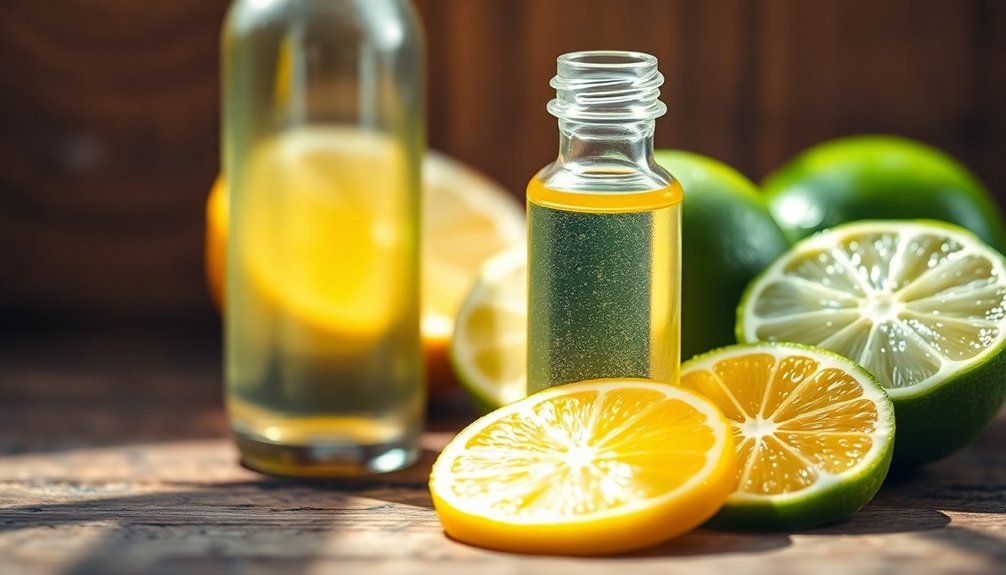
Citric acid stands as a powerhouse natural preservative for DIY perfumes, offering multiple preservation benefits beyond its familiar sourness. When you add it to your fragrance formulations, it creates an environment where harmful microorganisms can't thrive, effectively extending your perfume's shelf life.
You'll find citric acid particularly valuable for its pH-balancing capabilities, ensuring your perfume maintains ideal stability. It works by binding to metal ions that bacteria need to survive, creating a double-defense mechanism against spoilage. Being highly soluble in water, citric acid easily incorporates into your perfume base for seamless preservation.
This chelating action also prevents your fragrance from turning rancid or developing unwanted color changes.
As an added bonus, you're getting skincare benefits too. While protecting your DIY perfume, citric acid's antioxidant properties help maintain the freshness of your creation while offering gentle exfoliating effects when applied to skin.
Grapefruit Seed Extract: A Natural Antimicrobial Solution
Grapefruit seed extract provides an effective antimicrobial option for your DIY perfume formulations, with recommended usage levels between 0.1% to 1.0% in finished products.
You'll find this preservative works best when properly processed from grapefruit seeds and membranes, though commercial versions often contain additional synthetic ingredients for enhanced effectiveness.
When incorporating GSE into your perfume, make certain you're using water-soluble forms and storing them in cool, dark conditions to maintain their 24-month shelf life.
Extraction and Processing Methods
While traditional solvent extraction remains common, modern methods have revolutionized how you can process grapefruit seed extract for DIY perfumes.
You'll find supercritical fluid and enzyme-assisted extraction methods particularly effective, as they produce fewer impurities and use less solvent than conventional approaches.
To guarantee the highest quality extract for your perfume:
- Separate and dry the seeds and pulp at 150°-200°C for 24-48 hours until they develop a deep brown color
- Test the dried materials for pesticides to guarantee safety
- Grind the mixture in a hammermill to achieve uniform particle size
- Mix the ground seeds and pulp in an 80:20 ratio before extracting with heated glycerin solution
These processing steps help maintain the extract's antimicrobial properties while guaranteeing it blends seamlessly into your DIY perfume formulations.
Benefits and Usage Recommendations
Three key benefits make grapefruit seed extract (GSE) an excellent natural preservative for DIY perfumes.
First, it's effective against hundreds of bacterial, viral, and fungal strains while remaining safe for your skin at proper dilutions.
Second, you'll need only a small amount – 0.1% concentration is ideal for DIY formulations, making it cost-effective.
Third, GSE starts working quickly, disrupting harmful microbes within 15 minutes of contact.
To use GSE effectively in your perfume, you'll want to maintain a 0.1% concentration to avoid skin irritation while ensuring antimicrobial protection.
However, be aware that GSE won't work well if your perfume contains anionic ingredients, and its effectiveness often depends on synthetic preservatives present in commercial GSE products.
Always verify the GSE source you're using contains these necessary components.
Blending Preservatives for Maximum Effectiveness
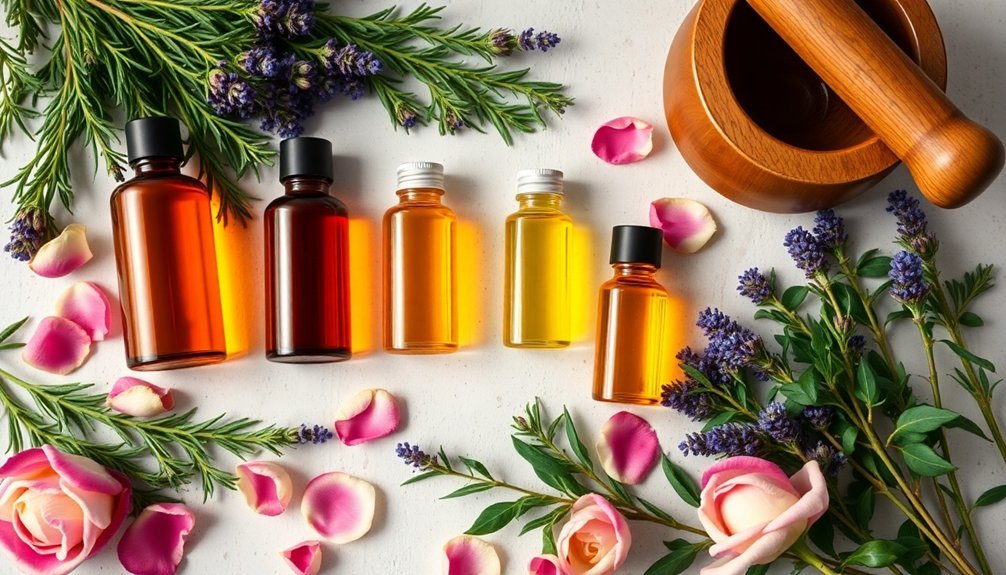
When creating your DIY perfume, you'll get better preservation by combining multiple natural preservatives that work together synergistically, such as pairing grapefruit seed extract with rosemary extract.
You can enhance your perfume's shelf life by incorporating essential oils that offer both fragrance and antimicrobial properties, like tea tree or lavender oil.
Balance your preservative system by using both water-soluble and oil-soluble natural preservatives to protect all aspects of your formulation.
Synergistic Preservative Combinations
To maximize the effectiveness of natural preservatives in DIY perfumes, combining specific preservative components can create powerful synergistic effects.
When you blend ingredients like caprylyl glycol with phenethyl alcohol and glyceryl caprylate, you'll get broad-spectrum protection against bacteria, yeasts, and molds while keeping irritation potential low.
- Mix oil-miscible glycols with preservative components to reduce the required amounts of each ingredient.
- Combine sorbic acid and potassium sorbate for enhanced protection against molds and yeasts.
- Pair phenethyl alcohol with ethylhexylglycerin for both preservation and skin conditioning benefits.
- Add natural extracts to synthetic preservatives like phenoxyethanol to boost antimicrobial properties.
Remember to evaluate your formulation's pH level, as it greatly influences the effectiveness of your chosen preservative blend.
Essential Oil Preservation Power
Proper blending of essential oils with preservatives requires careful attention to storage and handling practices that maximize their antimicrobial properties.
You'll need to store your essential oil blends in dark glass bottles – preferably cobalt blue, green, or amber – at temperatures between 15-21°C (60-70°F) to maintain their preservation power.
When creating your perfume formulations, transfer only what you'll use into smaller 10ml containers to minimize air exposure and oxidation.
Always use clean, airtight containers with blocking caps, and avoid plastic or metal vessels that could react with the oils.
Keep your blends in a cool, dry place away from sunlight and humidity.
Remember to label each container with the oil type and date, as the preservation effectiveness starts declining from the moment you open the bottle.
Balancing Different Natural Systems
Since natural preservatives often work best in synergy, blending different types creates a more robust preservation system for your DIY perfume.
You'll want to combine preservatives that offer different types of protection while ensuring they're compatible with your other ingredients. When creating your blend, stick to the upper limits of safe dosage ranges to guarantee protection in less controlled environments.
- Mix broad-spectrum preservatives like Leucidal Liquid with antioxidants like Vitamin E to prevent both microbial growth and oxidation.
- Test your preservative blend's effectiveness through PET (Preservative Efficacy Testing).
- Document your preservative combinations and their results for future reference.
- Consider cost-effectiveness when selecting multiple preservatives, as natural options can be pricier than synthetic alternatives.
Remember to maintain proper storage conditions to maximize your preservation system's effectiveness.
Storage Tips to Extend Your Perfume's Shelf Life
While creating your own natural perfume can be rewarding, storing it correctly makes all the difference in preserving its quality and extending its life.
Keep your fragrances in a cool, dark place around 60 degrees Fahrenheit, away from windowsills and heat sources. Your bedroom's drawers or closet shelves are ideal spots, as they're typically less humid than bathrooms.
Don't store your perfumes on high shelves where they might fall or get exposed to light. Instead, place them on lower shelves in their original boxes or dedicated perfume storage containers.
If you're dealing with humidity, consider using a dehumidifier or a beauty-specific mini fridge. For extra protection, use silicone bottle stoppers to create an airtight seal, and opt for smaller bottles that you'll use before they expire.
Signs Your DIY Perfume Needs Preservatives

Even with ideal storage conditions, your DIY perfume can develop signs that indicate it needs preservatives. If your fragrance contains water or has a measurable pH level, you'll need to protect it against microbial growth. Watch for changes in color, texture, or scent, as these can signal ingredient degradation.
- Your perfume develops a cloudy appearance or unusual particles, indicating potential microbial contamination.
- The scent changes dramatically or becomes musty, suggesting ingredient breakdown.
- The fragrance separates into layers, especially if it's an emulsion containing both water and oil.
- You notice any film formation on the surface or around the bottle's neck.
Pay special attention if you're storing your perfume in humid environments or if it's exposed to water during use.
For products intended to last beyond six months, preservatives aren't optional—they're essential for safety and stability.
Best Natural Preservatives for Oil-Based Perfumes
Natural preservatives play an essential role in protecting your oil-based perfumes from oxidation and microbial growth. When choosing preservatives for your DIY perfume, you'll find several effective natural options.
Vitamin E acts as a powerful antioxidant, while glycerin helps prevent moisture absorption that can lead to contamination.
For broad-spectrum protection, consider using benzyl alcohol or sorbic acid, which effectively combat mold and yeast growth. Salicylic acid offers additional stability by controlling microbial activity.
When incorporating these preservatives, you'll need to follow specific usage levels – typically around 1.5-2% of your formula. Remember to choose oil-soluble preservatives that are COSMOS and Ecocert certified to maintain your perfume's natural integrity.
Always verify the preservative's pH stability and compatibility with your other ingredients before adding it to your final formulation.
Water-Based Perfume Preservation Methods
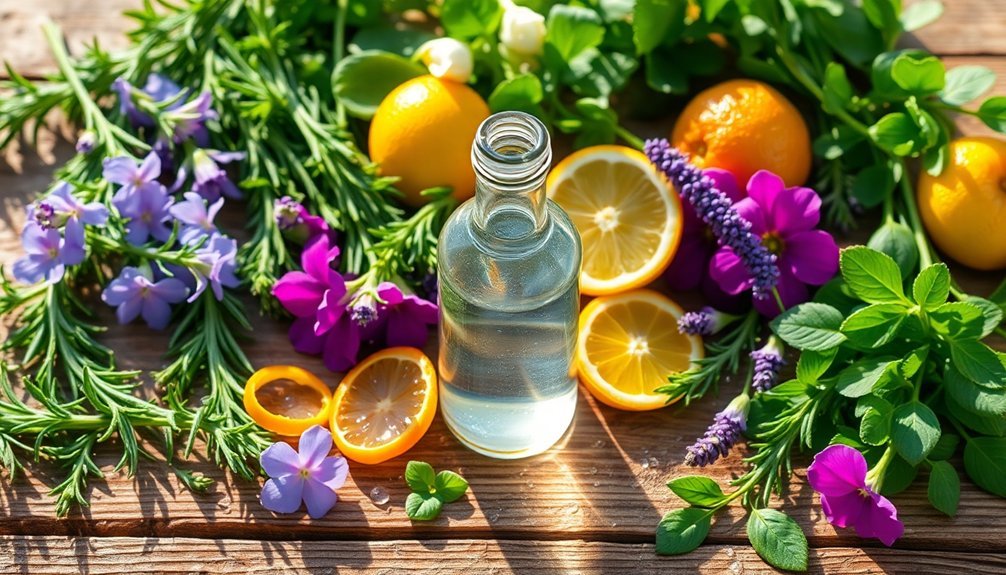
You'll need to start with a broad-spectrum antimicrobial preservative system when creating water-based perfumes to prevent bacterial growth and extend shelf life.
When working with citrus extracts, mix them with glycerin or other natural emulsifiers to guarantee proper dispersion and stability in your water-based formula.
Store your natural perfume blends in dark glass bottles with secure caps, keeping them in a cool environment away from direct sunlight to maintain their integrity.
Antimicrobial Preservative Importance
Water-based perfumes require effective antimicrobial preservatives to maintain their safety and quality over time.
You'll need broad-spectrum protection to guard against bacteria, yeast, and molds that thrive in moisture-rich environments. These preservatives work tirelessly to prevent cross-contamination and guarantee your fragrance stays fresh throughout its shelf life.
4 Critical Benefits of Antimicrobial Preservatives in Your DIY Perfume:
- Guards against both gram-positive and gram-negative bacteria, providing extensive protection
- Prevents the growth of harmful microorganisms that can spoil your creation
- Maintains the integrity of your fragrance's scent profile
- Extends your perfume's usable life by preventing premature degradation
When you're formulating your DIY perfume, don't underestimate the importance of proper preservation – it's the key to creating a safe, long-lasting fragrance you can enjoy with confidence.
Citrus Extract Safety Tips
Building on proper preservation methods, citrus extracts offer an appealing natural option for DIY perfumes – but they require specific handling for safe and effective use.
When working with citrus oils, you'll want to store them in cool, dark places to prevent oxidation of their high terpene content, especially d-limonene.
If you're creating water-based perfumes, combine citric acid with other natural preservatives like sodium benzoate or sorbic acid to maintain freshness and prevent bacterial growth.
For better stability, consider using distilled or folded citrus oils instead of cold-pressed versions, as they're less prone to spoilage.
You can also enhance your perfume's longevity by using micro-emulsion technologies that help distribute fragrance evenly.
Don't forget to shake your mixture regularly to maintain proper ingredient distribution and prevent separation.
Natural Blend Storage Solutions
Storage and preservation techniques play an essential role in extending the life of natural water-based perfumes.
While essential oils and grapefruit seed extract aren't reliable preservatives on their own, you'll need a thorough approach to keep your blend fresh and stable.
- Include alcohol at 20-30% of your formula to create an antimicrobial environment and help dissolve fragrance molecules effectively.
- If you're making an alcohol-free blend, use proven preservatives like phenoxyethanol or potassium sorbate rather than relying solely on essential oils.
- Keep essential oil concentrations at 1-2% to avoid skin irritation while still enjoying their natural fragrance benefits.
- Consider using emulsifiers when mixing water-based ingredients to prevent separation and maintain consistency in your perfume blend.
Remember that natural doesn't always mean effective when it comes to preservation.
Proper storage solutions require a balanced combination of proven ingredients.
Measuring and Adding Preservatives Safely
When working with natural preservatives in DIY perfumes, precise measurements and proper handling techniques are essential for both safety and effectiveness.
You'll need to calculate preservative amounts based on your total batch weight, typically using small percentages like 0.05% to 0.2%.
Always add preservatives after mixing your main ingredients, and make certain you're working in a clean environment to prevent contamination.
If you're using preservatives that need dilution, prepare this mixture separately before incorporating it into your perfume.
Stir thoroughly with a clean mixing tool to achieve uniform distribution.
Remember to check the pH level of your final blend, as most natural preservatives are weak acids that require specific pH ranges to work effectively.
Keep detailed records of your measurements and monitor your perfume's stability over time.
Testing Your Preserved DIY Perfume

Testing your preserved DIY perfume involves three critical phases: stability evaluation, physical assessment, and performance monitoring.
You'll need to expose your fragrance to various environmental conditions using climate chambers and UV light cabinets while checking for any changes in consistency, color, or scent profile.
Use tools like viscometers and spectrophotometers to track physical changes, and don't forget to conduct regular visual inspections for signs of instability.
For thorough testing, you'll want to:
- Perform accelerated stability tests at elevated temperatures
- Conduct freeze-thaw cycles to evaluate cold resistance
- Monitor real-time stability under normal storage conditions
- Test skin performance and longevity using white matte card stock or cotton balls
These methods will help guarantee your preserved perfume maintains its quality and effectiveness over time.
Frequently Asked Questions
Can Natural Preservatives Affect the Original Scent of My DIY Perfume?
Yes, natural preservatives can alter your perfume's original scent. You'll notice changes as essential oils blend and mature, while ingredients like beeswax and coconut oil interact with your fragrance over time.
How Long Should I Wait Before Wearing Preserved DIY Perfume?
You can wear your DIY perfume immediately, but letting it mature for 3-7 days allows scents to blend better. If you've used proper preservatives, the waiting period is more about scent development than safety.
Are Natural Preservatives More Expensive Than Synthetic Alternatives?
Yes, you'll find natural preservatives cost more than synthetic ones – often 2-20 times higher. They're pricier because they're produced in smaller batches and require more intensive extraction processes.
Can I Mix Different Types of Natural Preservatives Together?
Yes, you can mix natural preservatives, but you'll need to guarantee they're compatible. Test combinations carefully and maintain proper concentrations. Many preservatives work synergistically, enhancing each other's effectiveness in your formula.
Do Natural Preservatives Work Differently in Hot Versus Cold Climates?
Yes, you'll need stronger preservation in hot climates since heat accelerates microbial growth. Your natural preservatives may break down faster, so you'll want higher concentrations and proper storage to maintain effectiveness.
In Summary
Natural preservatives are your best allies in creating long-lasting DIY perfumes. You'll find that essential oils like tea tree and rosemary, combined with grapefruit seed extract or citric acid, can keep your fragrances fresh for months. Remember to test your preserved blends before regular use and store them properly in dark glass bottles. With these natural solutions, you've got everything you need to make safe, stable perfumes at home.

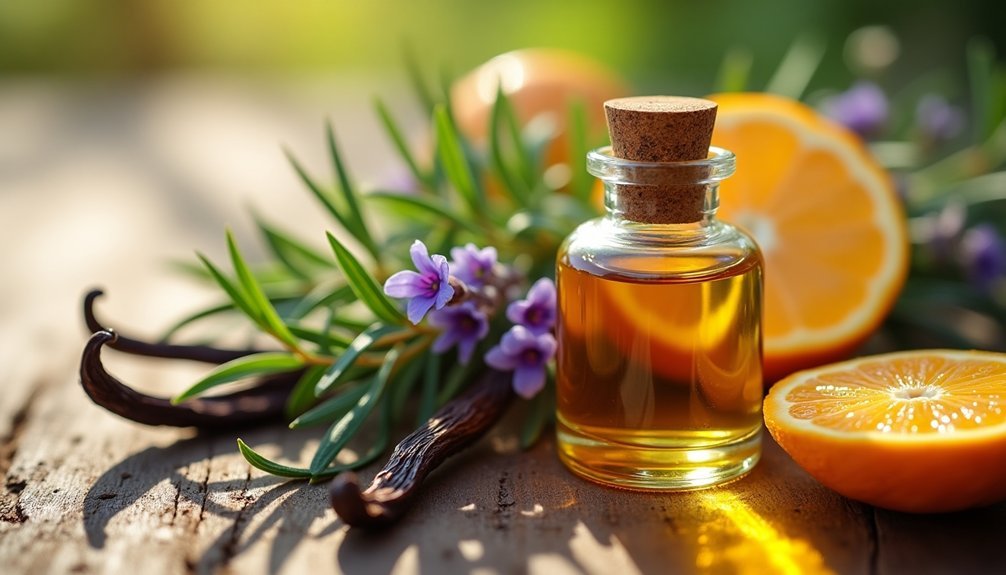



Leave a Reply